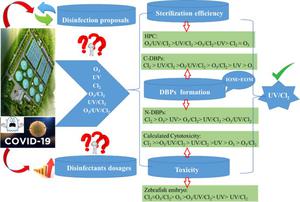Frontiers of Environmental Science & Engineering ( IF 6.1 ) Pub Date : 2024-07-05 , DOI: 10.1007/s11783-024-1875-5 Xiaobin Liao , Xinyue Liu , Yueyun He , Xueping Tang , Ruanjunjie Xia , Yongjun Huang , Wenhua Li , Jing Zou , Zhenming Zhou , Mazhan Zhuang

|
During the COVID-19 pandemic, most sewage treatment plants increased disinfectant dosages to inactivate pathogenic viruses and microorganisms more effectively. However, this approach also led to the production of more disinfection by-products (DBPs). To ensure both disinfection efficiency and a reduction in DBP formation, new disinfection protocols are required. In this study, the disinfection efficiency, DBP amounts, and toxicity changes resulting from ozone (O3), ultraviolet (UV), chlorine (Cl2), and their combined processes were examined. The results demonstrated that the O3/UV/Cl2 combination achieved the highest disinfection efficiency. Chlorination produced the most DBPs, whereas UV treatment reduced the formation of trihalomethane (THM), halogenated ketones (HKs), haloacetic acids (HAA), dichloroacetonitrile (DCAN) and N-nitrosodimethylamine (NDMA) by 45.9%, 52.6%, 82.0%, 67.95%, and 47%, respectively. O3 also significantly reduced their production by 99.1%, 91.1%, 99.5%, 100%, and 35%. Intracellular organic matter (IOM) was identified as the primary DBP precursors, producing 2.94 times more DBPs than extracellular organic matter (EOM). The increased DBP formation during chlorination was attributed to IOM leakage and cell membrane damage, which was verified using scanning electron microscopy (SEM). The toxicities of DBPs were evaluated for six disinfection methods, revealing inconsistent results. The overall toxicities were assessed using zebrafish embryo experiments. Both evaluations indicated that chlorination alone was the least favorable method. In addition, the toxicities followed a sequence: Cl2 ≈ O3/Cl2 > O3 > O3/UV/Cl2 > UV > UV/Cl2. These findings can serve as a reference for sewage treatment plants in selecting appropriate disinfection methods to manage the COVID-19 epidemic from comprehensive perspective.
中文翻译:

替代消毒方法或提高污水处理厂的消毒剂量以应对 COVID-19 大流行?从消毒效率、DBP形成和毒性角度
COVID-19大流行期间,大多数污水处理厂增加了消毒剂剂量,以更有效地灭活病原病毒和微生物。然而,这种方法也导致产生更多的消毒副产物(DBP)。为了确保消毒效率并减少 DBP 形成,需要新的消毒方案。在本研究中,臭氧(O 3 )、紫外线(UV)、氯(Cl 2 )及其组合过程引起的消毒效率、DBP量和毒性变化是检查了。结果表明,O 3 /UV/Cl 2 组合达到了最高的消毒效率。氯化产生最多的 DBP,而紫外线处理使三卤甲烷 (THM)、卤代酮 (HK)、卤乙酸 (HAA)、二氯乙腈 (DCAN) 和 N-亚硝基二甲胺 (NDMA) 的形成减少了 45.9%、52.6%、82.0% 、 67.95% 和 47% 。 O 3 的产量也显着减少了 99.1%、91.1%、99.5%、100% 和 35%。细胞内有机物 (IOM) 被确定为主要的 DBP 前体,产生的 DBP 是细胞外有机物 (EOM) 的 2.94 倍。氯化过程中 DBP 形成的增加归因于 IOM 泄漏和细胞膜损伤,这一点已通过扫描电子显微镜 (SEM) 得到验证。对六种消毒方法的 DBP 毒性进行了评估,结果不一致。使用斑马鱼胚胎实验评估总体毒性。两项评估均表明单独氯化是最不利的方法。此外,毒性遵循以下顺序:Cl 2 ≈ O 3 /Cl 2 > O 3 > O 3 > UV > UV/Cl 2 。 这些研究结果可以为污水处理厂从综合角度选择合适的消毒方法来管理COVID-19疫情提供参考。











































 京公网安备 11010802027423号
京公网安备 11010802027423号